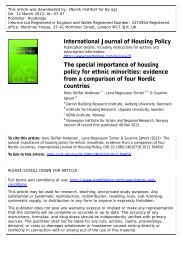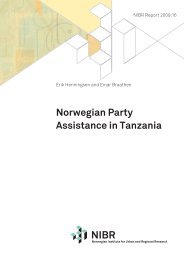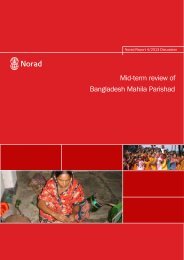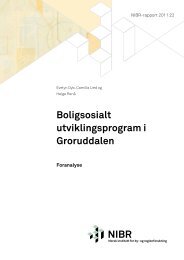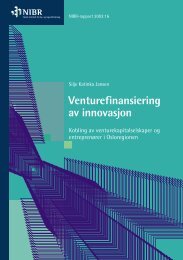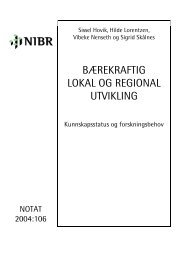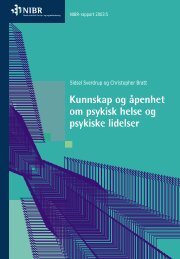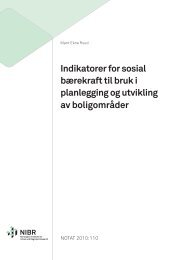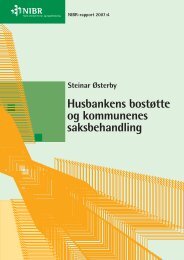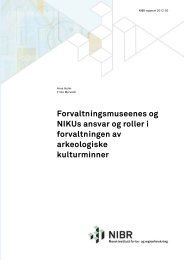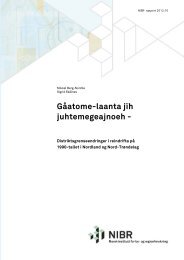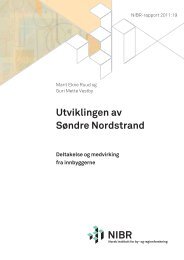Mid-Term Review of the Norwegian Action Plan for Women's ... - Norad
Mid-Term Review of the Norwegian Action Plan for Women's ... - Norad
Mid-Term Review of the Norwegian Action Plan for Women's ... - Norad
Create successful ePaper yourself
Turn your PDF publications into a flip-book with our unique Google optimized e-Paper software.
initiatives in Norway, <strong>the</strong> launch <strong>of</strong> <strong>the</strong> GEAP itself, and one year later <strong>of</strong> <strong>the</strong> White Paper On Equal<strong>Term</strong>s which were important events in <strong>the</strong>mselves.It has been difficult <strong>for</strong> <strong>the</strong> <strong>Review</strong> Team to assess WRGE’s place in policy dialogue with partnercountries and at <strong>the</strong> country level. Norway no longer has annual country meetings with writtenmandates and minutes. In several countries Norway engages in Joint Assessment Strategies, where <strong>the</strong>main policy dialogue with <strong>the</strong> partner country seems to be related to General Budget Support, andwhere WRGE is not a prominent topic, although it is included in <strong>the</strong> policy markers. In general itshould be said that <strong>the</strong>re is less visibility <strong>of</strong> WRGE’s work in Norway and in bilateral aid, than inmultilateral meetings and arenas. It seems to <strong>the</strong> <strong>Review</strong> Team that it is easier <strong>for</strong> <strong>the</strong> gender advisers topush <strong>for</strong> WRGE work in multilateral meetings and donors than inside <strong>the</strong>ir own system.Has Norway increased its relative funding to projects and programmes supporting women’s rights and gender equality?In 2007 and 2008 statistics show an increase in relative funding to programmes and projects, part <strong>of</strong>which is due to changes in <strong>the</strong> statistical registration system. The marker on gender as a main objectiveshowed a stagnation from 2007 to 2008, but <strong>the</strong> overall relative use <strong>of</strong> <strong>the</strong> gender marker increasedfrom 20% in 2005 to 30% in 2008. However, this is still a relatively low score. One should consider that<strong>the</strong> score on <strong>the</strong> gender marker depends considerably on <strong>the</strong> composition <strong>of</strong> aid. Governance andhuman development generally score high on <strong>the</strong> gender marker, while o<strong>the</strong>r sectors, such asinfrastructure, energy, etc., score low. This should encourage even stronger work on gendermainstreaming in <strong>the</strong>se important sectors <strong>of</strong> development cooperation.Has Norway increased gender mainstreaming in its development cooperation?The Evaluation <strong>of</strong> 2005 pointed to <strong>the</strong> fact that gender mainstreaming was <strong>the</strong> main challenge <strong>for</strong> <strong>the</strong>MFA and <strong>Norad</strong>. This challenge remains, and evidence <strong>of</strong> gender mainstreaming is weak. This is clearly<strong>the</strong> weakest part <strong>of</strong> <strong>the</strong> WRGE work, and both <strong>the</strong> MFA and <strong>Norad</strong> admit that this is a subject/topicthat <strong>the</strong>y have not worked on consistently. Few ef<strong>for</strong>ts and resources have been invested into analyticand catalytic ef<strong>for</strong>ts <strong>for</strong> gender mainstreaming. The Gender budget line was designed to support <strong>the</strong>implementation <strong>of</strong> <strong>the</strong> GEAP, but <strong>the</strong> guidelines mainly focus on women targeting projects andprogrammes, and not on promoting gender mainstreaming in an innovative and catalytic way.Guidelines and management systems <strong>for</strong> <strong>the</strong> gender budget line will be revised spring 2009, and shouldtake this into consideration. The Team also believes <strong>the</strong>re is still substantial under-reporting <strong>of</strong> goodgender mainstreaming. The MFA and <strong>Norad</strong> <strong>the</strong>re<strong>for</strong>e need to look at reporting <strong>for</strong>mats to better cover<strong>the</strong> substantial good work that has been done.Has Norway improved <strong>the</strong> organisation <strong>of</strong> its development cooperation, to ensure <strong>the</strong> necessary capacity, competence andgovernance in its work on women’s rights and gender equality?The GEAP was never operationalised in <strong>the</strong> annual plans and reports, even if this was stated explicitlyin <strong>the</strong> GEAP itself. A three-year internal project on WRGE was established in <strong>the</strong> summer <strong>of</strong> 2006 in<strong>the</strong> MFA, but evaporated shortly after <strong>the</strong> GEAP was launched. The Internal Gender Resource Group<strong>for</strong> <strong>the</strong> project became more or less non-functional after <strong>the</strong> GEAP was launched and has had no rolein <strong>the</strong> follow-up <strong>of</strong> <strong>the</strong> GEAP, except in review applications <strong>for</strong> <strong>the</strong> Gender budget line; this is in spite<strong>of</strong> having a proper mandate <strong>for</strong> such work.The evaluation <strong>of</strong> 2005 documented a weak administrative capacity, lack <strong>of</strong> staff, and weak trainingef<strong>for</strong>ts, as well as weak planning and reporting systems <strong>for</strong> WRGE. The staffing has been streng<strong>the</strong>ned;<strong>the</strong>re are more gender advisers, and small teams <strong>of</strong> gender advisers in FLID and in GIL. However, weagree with <strong>the</strong> findings <strong>of</strong> <strong>the</strong> latest OECD/DAC peer review (OECD/DAC 2003) that staffing is stillweak and thinly spread in <strong>the</strong> organisation. Training has not found a relevant <strong>for</strong>m to attract staff, andgovernance systems are still weak when it comes to holding <strong>the</strong> system accountable <strong>for</strong> reporting onimplementation <strong>of</strong> <strong>the</strong> GEAP and results <strong>of</strong> WRGE’s work. The <strong>Review</strong> Team has not had <strong>the</strong>opportunity to compare <strong>the</strong> MFA’s and <strong>Norad</strong>’s capacity <strong>for</strong> implementation <strong>of</strong> o<strong>the</strong>r action plans orpriority areas, but <strong>the</strong>re is a clear impression from discussing <strong>the</strong> issue with staff that o<strong>the</strong>r priorityareas, such as environment and climate change, and cleaner energy technology, are given moreresources, such as <strong>the</strong> redefinition <strong>of</strong> a number <strong>of</strong> councillor positions at <strong>the</strong> embassies as energy andclimate councillors.44



